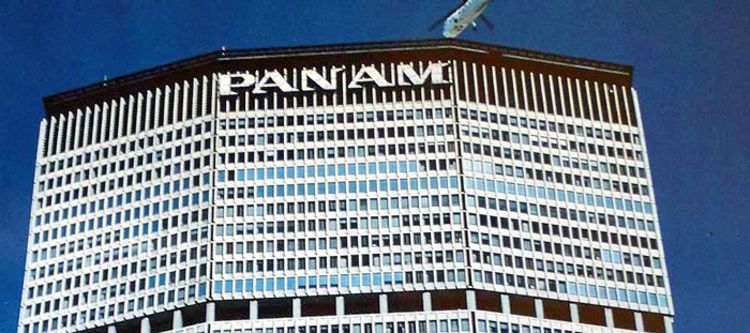AIR RIGHTS
And the birth of the Pan Am Building

Train tracks north of Grand Central Terminal before they were covered over, c. 1910. Image:
Train tracks north of Grand Central Terminal before they were covered over, c. 1910. Image:
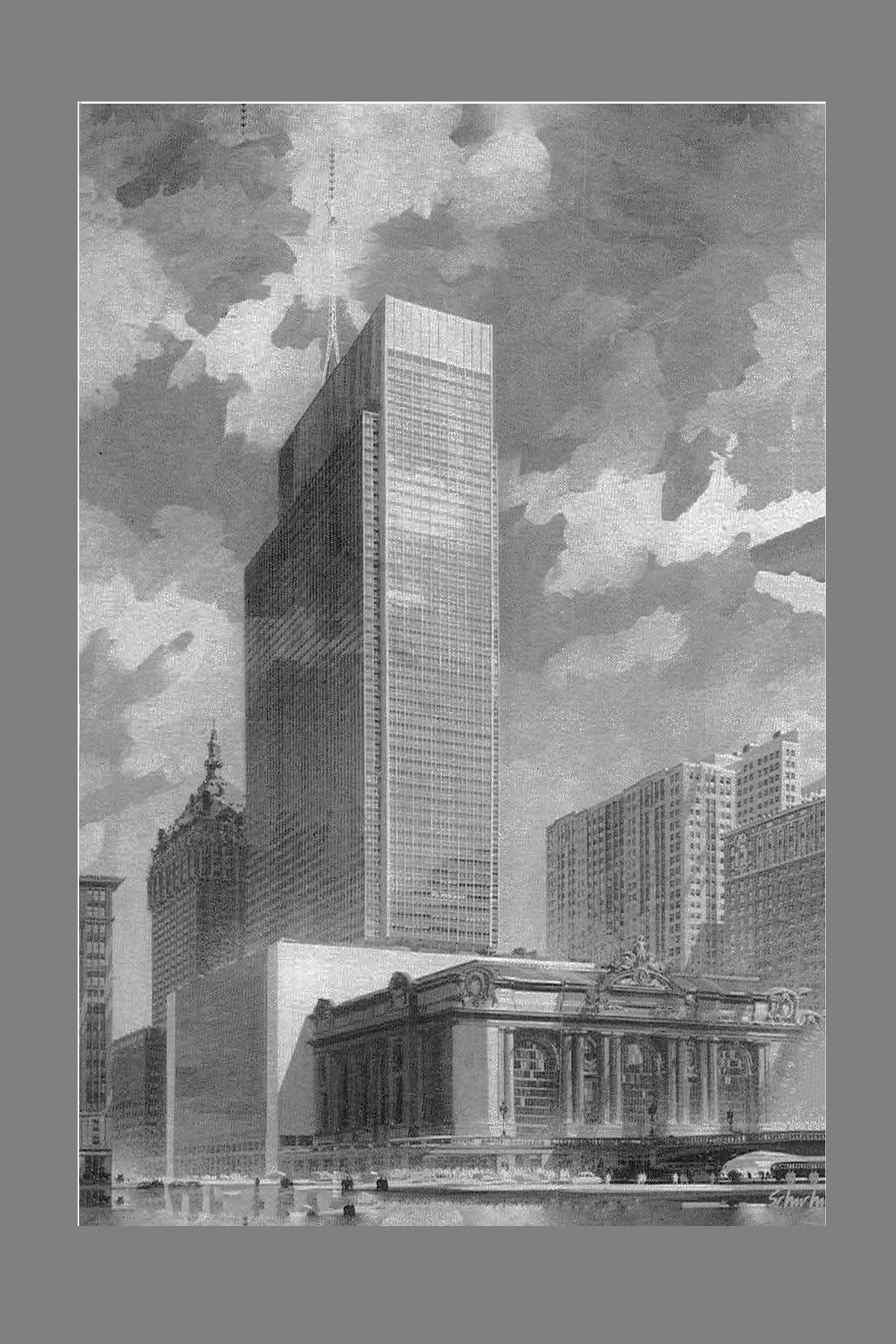
Video Clip:
American Experience "Grand Central"
Grand Central's builders pioneered the concept of air rights. Engineer William Wilgus called it "taking wealth from the air." Once the New York Central's tracks were electrified and buried below street level, the space above was leased to real estate developers to pay for the entire project. Today, few who walk north on Park Avenue in New York City realized the tracks are below them.
The Modern Approach
Years rolled by, and the railroads’ star had faded in post World War Two.
The two railroad owners who partnered in GCT were property-rich but increasingly cash-strapped. The Terminal itself had an operating deficit of $6 million annually. It was showing its age and by mid-century was dilapidated and dirty. The privately owned and operated passenger rail system it served was itself becoming an anachronism, given America’s growing highway system and ever-more popular air travel.
The long-term lease revenue received from buildings along Park Avenue did not keep pace with expenses, particularly property taxes. And the older buildings themselves, some with 18-room apartments that were built with those leased air rights, had seen a dramatic decline in rents in New York’s rent-controlled environment. Old buildings started to give way to to office towers built for corporate headquarters. A parade of gleaming glass-curtain-walled “International” style buildings began to dominate Park Avenue north of Grand Central.
In 1954, New York Central got new leadership. Robert Young came onboard as Chairman, determined to find a solution to the growing deficit incurred by GCT’s expenses. The approach he took was to solicit ideas from developers and architects who could build a new revenue-producing structure on railroad property. The target site for this plan was GCT itself. It was a rebirth of the old vision for development from the early 1900s.
Robert Young, Chairman of New York Central Railroad may have been motivated by the new construction going up along Park Avenue, such as Lever House and the Seagram Building.
Building Inspiration
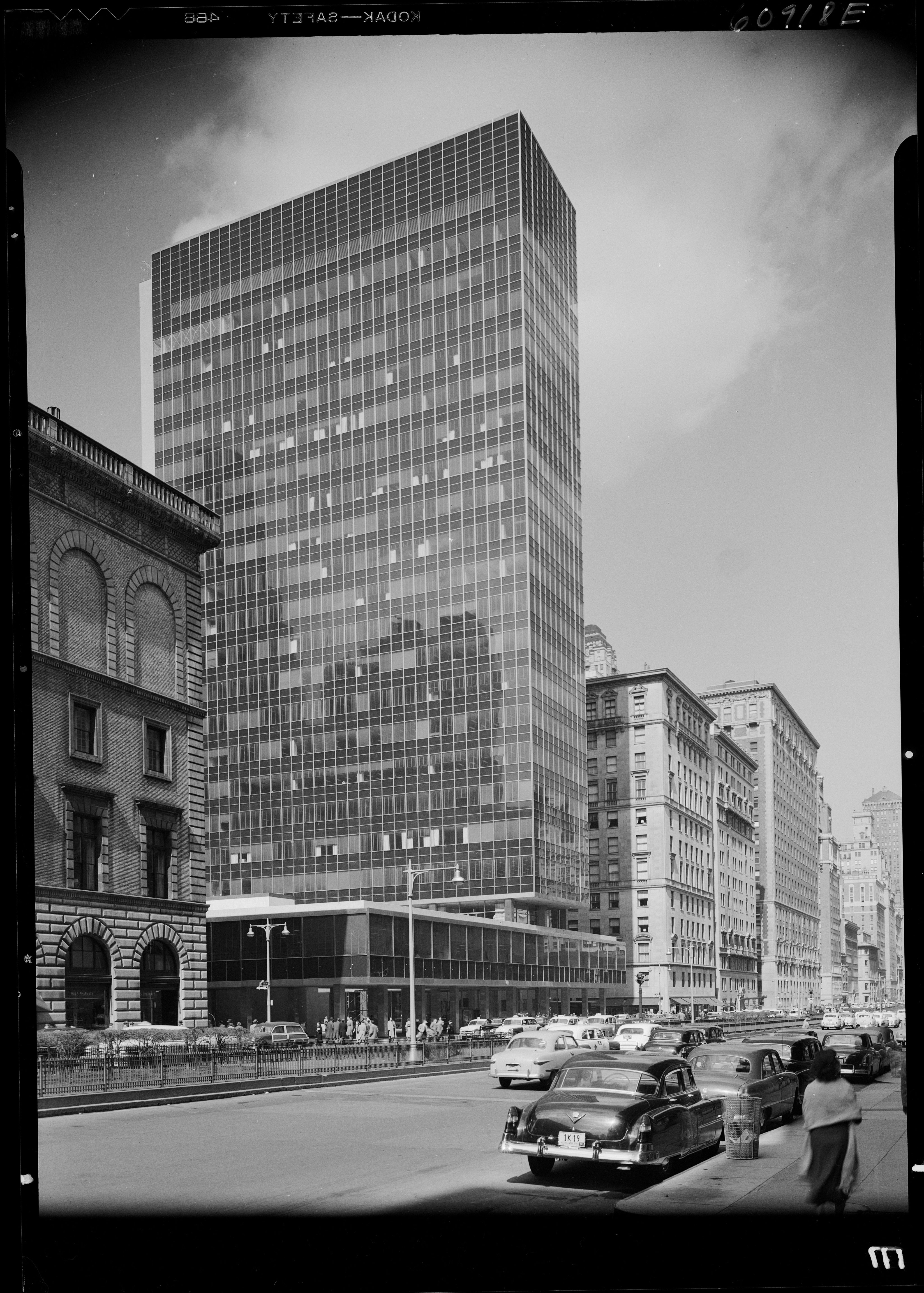
March 25, 1952: Lever House, 53rd St. and Park Ave., New York City, Exterior by Gottscho-Schleisner, Inc. photographer (Library of Congress).
March 25, 1952: Lever House, 53rd St. and Park Ave., New York City, Exterior by Gottscho-Schleisner, Inc. photographer (Library of Congress).

January 3, 1958, New York City: The Seagram Building. Night Views, Gottscho-Schleisner, Inc photographer ( Library of Congress).
January 3, 1958, New York City: The Seagram Building. Night Views, Gottscho-Schleisner, Inc photographer ( Library of Congress).
Grand Central CitY - WHAT MIGHT HAVE BEEN
In late 1954, various architectural concepts were submitted for consideration by the railroad.
These included a plan by Alfred Fellheimer and Stewart Wagnar, and another eighty-story design by I.M. Pei, dubbed the “Hyperboloid." Both designs called for the destruction of the Terminal itself.
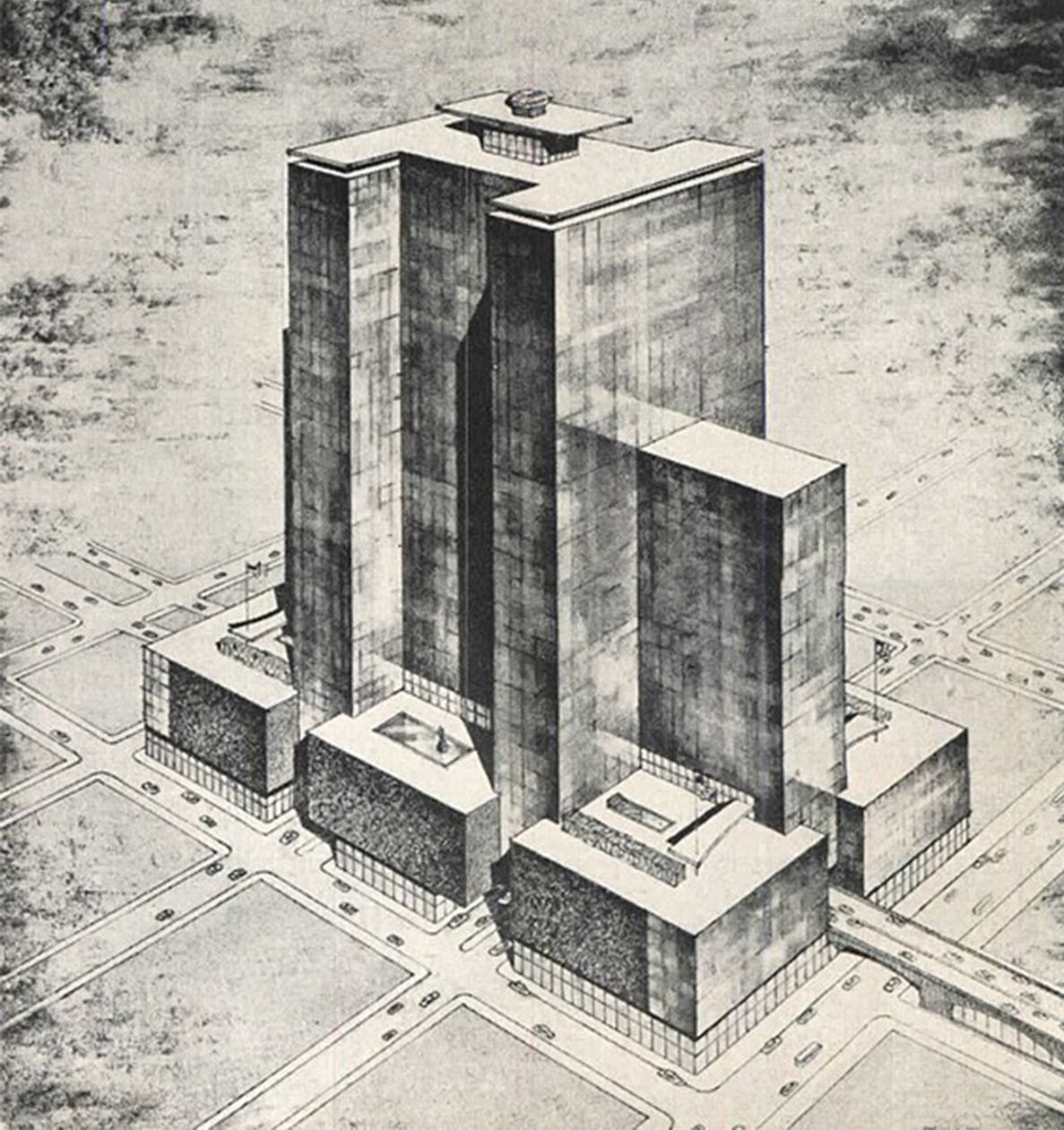
1954: Alfred Fellheimer and Stewart Wagnar's proposed replacement for Grand Central Terminal, drawn by its own lead architect about 40 years later. Architectural Record description: "Rendering of Fellheimer and Wagner proposal for scheme to replace existing terminal building (completed in 1913) looking east across Vanderbilt Avenue, with Forty-third and Forty-fourth streets in left foreground. Setback roofs are envisioned as roof gardens adjoining restaurants and stores on adjacent tower floor. Roof would provide helicopter landing field".
1954: Alfred Fellheimer and Stewart Wagnar's proposed replacement for Grand Central Terminal, drawn by its own lead architect about 40 years later. Architectural Record description: "Rendering of Fellheimer and Wagner proposal for scheme to replace existing terminal building (completed in 1913) looking east across Vanderbilt Avenue, with Forty-third and Forty-fourth streets in left foreground. Setback roofs are envisioned as roof gardens adjoining restaurants and stores on adjacent tower floor. Roof would provide helicopter landing field".
Preserving Grand Central Terminal
Not long after, in early 1955, yet another plan surfaced, this one from architects Emery Roth and Sons working with developer Erwin Wolfson.
This concept, dubbed “Grand Central City,” proposed a fifty story tower rising from a wider ten-story base. Unlike other concepts, this plan, as seen below, would preserve the forty-two year old GCT Concourse.

While many proposed tearing down Grand Central, this 1955 Emery Roth and Sons building plan, with its north-south axis, would preserve the Beaux Art building.
THE DECISION OF 1955
New York Central Chairman Young, after some consideration of these alternatives, decided to go with the “Hyperboloid” plan.
But there was a growing public sensitivity to the notion of destroying the old station. That, coupled with uncertain financing, torpedoed the plan’s momentum and it soon faded.
I.M. Pei's "Hyperboloid" design with an 88-floor office tower would have replaced Grand Central Terminal entirely.
a plan is revived in 1958
By chance, early in 1958, Erwin Wolfson learned that a potential tenant was interested in the abandoned Grand Central City design from three years before.
Wolfson went back to Young, who by this time was ready to encourage Wolfson. If anything, the financial challenge of operating Grand Central had only worsened in the intervening time, and the prospect of new revenue from leasing air rights to Wolfson was a powerful incentive for New York Central Railroad.
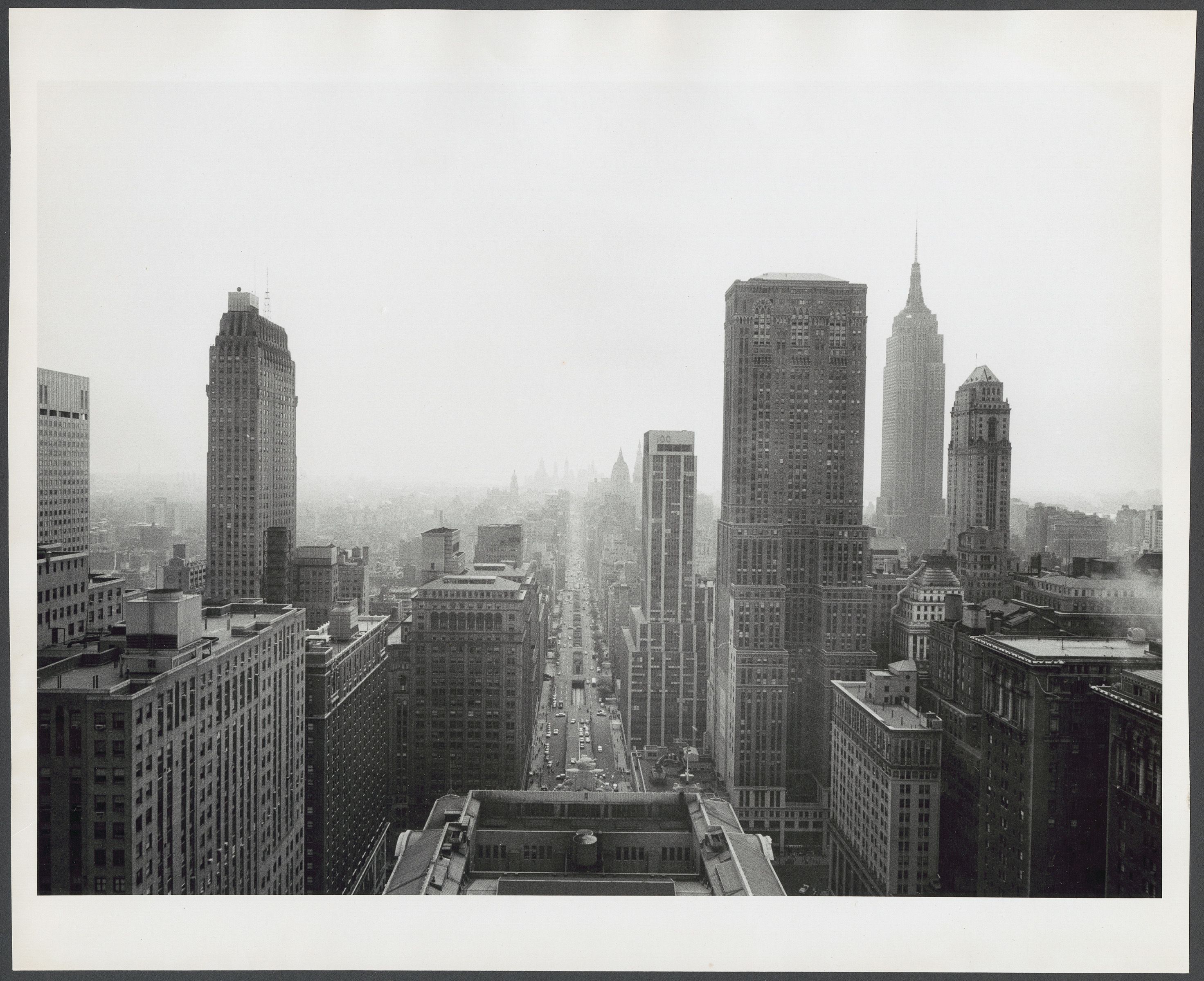
Image: August 1958, looking down Park Avenue South from Grand Central. "Photograph shows bird's eye view of Grand Central Terminal and Park Avenue. One Grand Central Place, the Mercantile Building, and the Empire State Building are visible to the right."
Image: August 1958, looking down Park Avenue South from Grand Central. "Photograph shows bird's eye view of Grand Central Terminal and Park Avenue. One Grand Central Place, the Mercantile Building, and the Empire State Building are visible to the right."
Wolfson and Roth
There was every reason for Robert Young to believe the project would succeed if it was pushed forward by Erwin Wolfson's Diesel Construction and Emery Roth and Sons.
Both firms had a very good track record, having worked together earlier on several large, successful developments in New York City. Emery Roth's architecture firm was noted for designs that lent themselves to efficient, cost-effective construction. Emery’s sons, MIT-trained architect Richard, and Julian, who was an engineer, joined the firm as partners in 1938.
The architects’ approach to design meshed well with Erwin Wolfson, owner of Diesel Construction, who built structures for clients and financed some buildings himself as well. He was known for taking a careful and well-planned approach to building projects, and was well acquainted with the nuts-and-bolts of the construction business, having experienced a meteoric rise and fall in the Florida land boom of the 1920s. Also, during the Great Depression, he parlayed a diesel generator installation business into a comprehensive building construction enterprise, (hence the name of his company).
New York City had become the center of global finance and business, and corporate clients were eager to establish a presence there. The expanding economy of post-war New York City provided ample opportunities for Diesel Construction to invest in and construct office facilities.
With Emery’s passing, and architectural tastes changing after WWII, the Roth architectural firm turned to more contemporary designs, improving on the firm’s penchant for using cost-effective materials and techniques. This worked very well with the advent of the “modernist” aesthetic, that rejected the historicism and adornment of buildings of Emery Roth’s generation.
THE PAN AM PODCAST WITH TOM BETTI
Episode 10: The Pan Am Building, A Landmark of New York City featuring an interview with Richard Roth, Jr.
